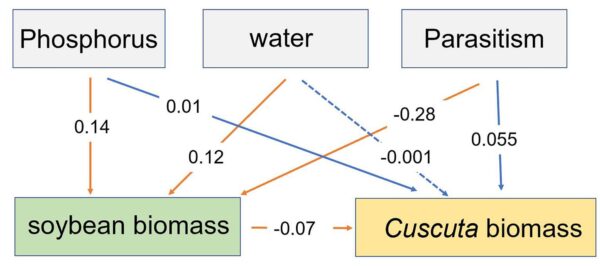Introduction: Parasitic plants can damage crop plants and consequently cause yield losses and thus threaten food security. Resource availability (e.g., phosphorus, water) has an important role in the response of crop plants to biotic attacks. However, how the growth of crop plants under parasitism are affected by environmental resource fluctuation is poorly understood.
Methods: We conducted a pot experiment to test the effects of the intensity of Cuscuta australis parasitism and the availability of water and phosphorus (P) on soybean shoot and root biomass.
Results and discussion: We found that low-intensity parasitism caused ~6% biomass reduction, while high-intensity parasitism caused ~26% biomass reduction in soybean. Under 5–15% water holding capacity (WHC), the deleterious effect of parasitism on soybean hosts was ~60% and ~115% higher than that under 45–55% WHC and 85–95% WHC, respectively. When the P supply was 0 μM, the deleterious effect of parasitism on soybean was 67% lower than that when the P supply was 20 μM. Besides, the biomass of C. australis was highest when both the water and the P availability were lowest. Cuscuta australis caused the highest damage to soybean hosts under 5 μM P supply, 5–15% WHC, and high-intensity parasitism. Additionally, C. australis biomass was significantly and negatively related to the deleterious effect of parasitism on soybean hosts and to the total biomass of soybean hosts under high-intensity parasitism, but not under low-intensity parasitism. Although high resource availability can promote soybean growth, the two resources have different impacts on the response of hosts to parasitism. Higher P availability decreased host tolerance to parasites, while higher water availability increased host tolerance. These results indicate that crop management, specifically water and phosphorus supply, can efficiently control C. australis in soybean. To our best knowledge, this appears to be the first study to test the interactive effect of different resources on the growth and response of host plants under parasitism.
Frontiers in Plant Science 14:1177154, 2023.
